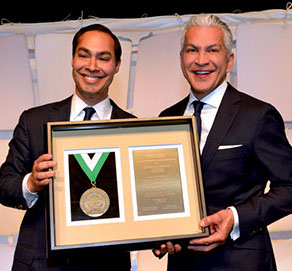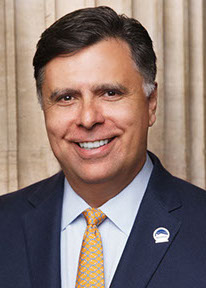
Providing Affordable Internet
In a 21st century global economy, where brainpower is the one of the greatest assets for success, the Internet is an essential tool for all.
Despite the ubiquity of technology in American life, there remains a digital divide in which one in four households do not have access to the Internet at home especially lower-income Latino families. Millions of families and people of modest means are striving for success, yet lack the ability to complete homework assignments online, apply for college or a new job, and access the abundance of opportunities on the Internet.
modest means are striving for success, yet lack the ability to complete homework assignments online, apply for college or a new job, and access the abundance of opportunities on the Internet.
Lisa, a mother of four, said that the Internet, “to some people may seem like a little thing but to people who cannot afford it, it means a lot.” Her youngest, a 16-year-old student at Miami High, is doing well in his classes, but to complete projects he has no choice but to go to the library or a friend’s house with Internet access. Yet this is more than just an inconvenience, for families like Lisa’s, this divide is the difference between opportunity and falling behind.
To address this challenge, the Obama Administration launched ConnectHome-an initiative led by U.S. Secretary of Housing and Urban Development (HUD) Julián Castro to encourage community groups and corporations to connect families living in public or assisted housing to the Internet. This effort strives to ensure every student can access the same level of high-speed Internet at home that they have in their classroom at school. After a pilot program in 28 communities across America, this next phase seeks not only to serve students, but also adults without children, older residents, and veterans.
Last month, Comcast reaffirmed its commitment to bridging the digital divide with a massive expansion of broadband adoption through Internet Essentials. This Comcast program provides low-cost high-speed broadband for $9.95 a month, the option to purchase an Internet-ready computer for under $150, and multiple choices to access free digital literacy training in print, online, and in-person. Since its inception in 2011, Internet Essentials has connected more than 750,000 low-income families to the Internet at home, benefitting over 4.4 million Americans.
Now as a ConnectHome partner, Comcast is offering public housing and HUD-assisted residents, who live in Comcast’s service areas, the ability to apply for Internet Essentials. This program will have the greatest impact within numerous minority communities. According to HUD, 45% of heads of households in HUD-funded affordable housing are African American and 24% are Hispanic. In total, more than 75% heads of households are women. In Miami alone Internet essentials has connected 22,600 of the 35,000 eligible households and more than 96,600 of the 136,000 in Florida. Overall, an estimated 2 million HUD-assisted homes-forty percent of all HUD-assisted households nationwide-will now have access to low-cost Internet service. According to Internet Essentials customer research, 55 percent of the program participants are Latinos, meaning tens of thousands of Latino families now have access to broadband at home for the first time through Internet Essentials.
Students, huddling on their phones outside the public library for a Wi-Fi signal, will be able to work on homework and fill out FAFSA forms for college in their home. Older residents, disconnected from family, will be able to video chat with loved ones, pay bills, or shop online in their home. Veterans, transitioning from the armed services to the workforce, will be able to apply for jobs or higher education and access healthcare information in their home.
This effort is not a little thing, as Lisa said, and expanding the opportunities of the Internet to more hardworking people, particularly in underserved communities, means a lot. We are proud of this partnership, and we are dedicated to ensuring every person in the United States has the essential tool of the Internet to pursue their full potential.
Javier Palomarez is the President and CEO of the U.S.Hispanic Chamber of Commerce.
Hispanic Wealth Project
The subject of wealth is a topic that has historically eluded our community. Nonetheless, when Hispanic household wealth in the U.S stands at nearly 10 times less than that of White households, it is a subject our community leaders must collectively address and provide actionable steps to close the divide.
 In 2014, the National Association of Hispanic Real Estate Professionals (NAHREP) launched the Hispanic Wealth Project to address the Latino wealth gap in America. NAHREP’s leaders feel they are uniquely qualified to drive this effort because of its large base of 26,000 real estate professionals. These members are primarily made up of Hispanic business owners whose influence extends deep into hundreds of Latino neighborhoods and who are considered by many in their communities as trusted advisors for homeownership as well as a wide range of financial matters. Essentially, if NAHREP’s members can help facilitate sustainable homeownership for millions of Hispanic families while concurrently implementing new disciplines in the area of wealth and prosperity in their own lives and businesses, the cascading effect can be exceptionally positive.
In 2014, the National Association of Hispanic Real Estate Professionals (NAHREP) launched the Hispanic Wealth Project to address the Latino wealth gap in America. NAHREP’s leaders feel they are uniquely qualified to drive this effort because of its large base of 26,000 real estate professionals. These members are primarily made up of Hispanic business owners whose influence extends deep into hundreds of Latino neighborhoods and who are considered by many in their communities as trusted advisors for homeownership as well as a wide range of financial matters. Essentially, if NAHREP’s members can help facilitate sustainable homeownership for millions of Hispanic families while concurrently implementing new disciplines in the area of wealth and prosperity in their own lives and businesses, the cascading effect can be exceptionally positive.
Together with partners such as Wells Fargo, the Hispanic Wealth Project aims to triple Hispanic household wealth by 2024 via the three component goals we released in our Annual State of Hispanic Wealth Report this year: (1)Sustainable Homeownership: Achieve a 50 percent (or greater) rate of U.S. Hispanic homeownership because it is the primary vehicle for wealth creation for the middle class; (2) Entrepreneurship: Increase the success rate of Hispanic-owned small businesses,because small business is the engine that drives the U.S. economy; and (3) Savings and Investment: Increase by 25 percent the number of Hispanic households owning non-cash financial assets (e.g. stocks, bonds, mutual funds, 401k accounts) because the lack of asset diversification was a primary reasons Hispanics lost nearly two-thirds of their median household wealth between 2008 and 2013; more than any other ethnic demographic.
These are aggressive goals but our report’s findings demonstrate that there is a powerful shift in our community as we stake claim our spot as the new mainstream. For example, Hispanics accounted for 69 percent of the total net growth in U.S. homeownership in 2015. Remarkably, for the first time in 10 years, the Hispanic homeownership rate spiked upward while the overall U.S. homeownership rate continued a downward trend.
Hispanics also continue to drive U.S. employment growth, accounting for 66 percent of U.S. labor force growth and 73 percent of the increase in U.S. workers employed between 2000 and 2015. Hispanics are also leading entrepreneurship with 4.1 million Hispanic-owned businesses and the highest rate of new business starts in 2015.
Despite these gains, our community needs to improve its understanding of sustainable wealth building principles and tools. Whereas 36 percent of White households have taxable investment accounts, only 25 percent of Hispanics take advantage of these accounts. With respect to stock ownership specifically, only 17 percent of Latino households own stock compared to 55 percent of White households.
Nobody can question the resilience and work ethic of the Hispanic community in America after all many of us are in this country in the first place for the economic opportunities that exist in this great land. We are also the youngest ethnic group by far which also means that the economic well being of the Hispanic community is intrinsically tied to the overall prosperity of America. NAHREP’s plan, while ambitious, is attainable with the coordinated commitment of the community and a wide range of stakeholders including corporations; foundations and government.
In less than two years, the Hispanic Wealth Project has inspired the commitment of several major corporations and non-profit groups including Wells Fargo, Quicken Loans, Bank of America, Freddie Mac, Union Bank, and Base 11. For more information about the Hispanic Wealth Project and how to get involved, please visit us at our website at www.hispanicwealthproject.org.
Gary Acosta is the Founder of the Hispanic Wealth Project.